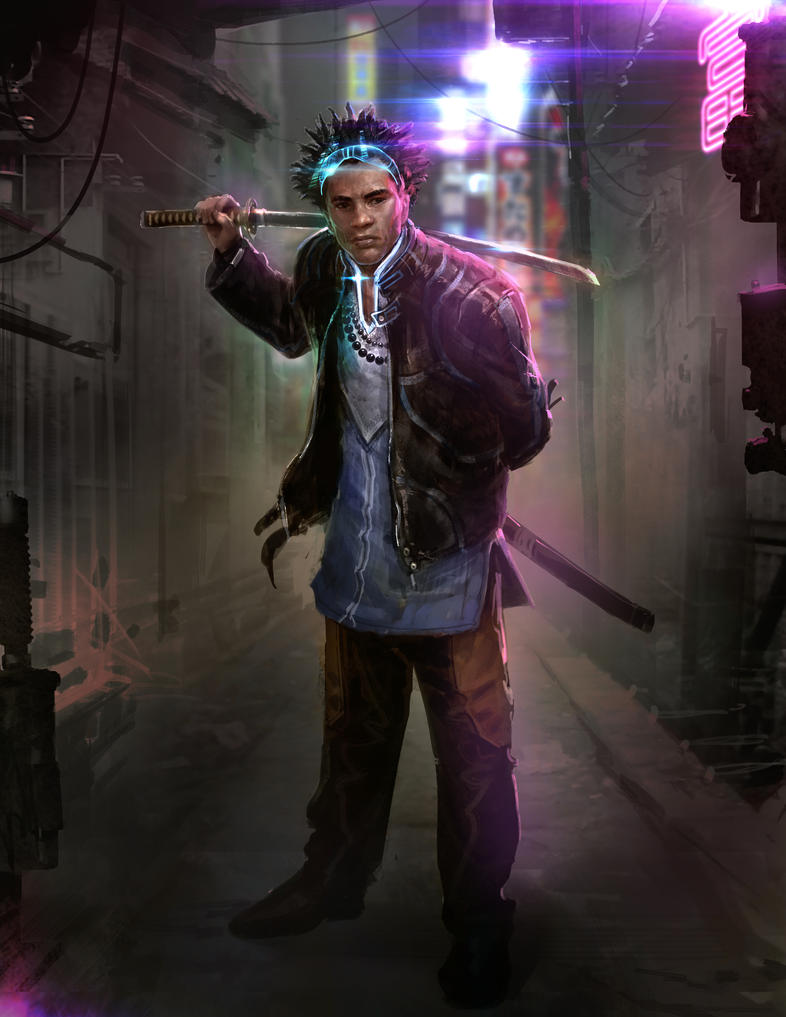My main gaming interests may be DM Theory and designing and running adventures... But when I do get a chance to play I like to be characters who are interesting and entertaining! In order to keep my characters fun and thought out, I usually limit myself to a handful of old standbys. Today I would like to share a synopsis of the characters that I play when I find myself on the other side of the screen.
They can each be adapted to any system, so I typically define them by archetype, the general style and inclination of their character. I will also include the traits that define them as well as the party members they will be most drawn to, because I think this is always important to building a cohesive group. Also, most of them are at least partly inspired by some famous performer or character, because it gives me a fun foundation to build off, and helps me quickly establish the character's look and voice. Some folks prefer playing as basically themselves in a game, and some don't like to act out their part so much, but this is my preferred way of playing. Hopefully you will find this entertaining and perhaps glean some spark of inspiration from these fellows, as I have from observing the characters I have played alongside.
1. Tracer Ero (Rogue archetype)
1. Tracer Ero (Rogue archetype)
Tracer is a Lawful Neutral rogue, that is he is a 'professional' thief. He takes personal pride in his work, and serves the needs of whoever is currently employing him (Usually the highest ranking party member on his team.) He is loyal but socially inept, unable to relate to the world outside of the context of his militaristic training and discipline. Inspirations for the character include Batman, Solid Snake, Snake Eyes from GI Joe, and Sosuke Sagara of Full Metal Panic! Tracer's name comes from the Calvin and Hobbes comic strip character Tracer Bullet.
2. Dave Presley (Paladin/Fighter archetype)
Dave was inspired by Louis CK's police officer character from Parks and Recreation. Staunch and uptight, Dave is nonetheless compassionate and protective of the weak. He speaks in a stodgy but friendly manner, and tries to enforce the law as firmly and compassionately as possible. He will often view himself as bodyguard and protector to the weakest or gentlest member of the team.
3. Zelda Wyldfyre (Rogue archetype)
Zelda is a renegade who is out to get rich and live in a palace. She is the chaotic antithesis of Tracer Ero, a street urchin turned criminal. Dynamic and free-spirited, she will relate most to whichever party member comes from the humblest origins. She is based on actress Willa Holland (I don't like to play characters of a gender opposite of my own unless their voices and mannerisms are very distinctive, and I feel like she fits the bill.)
Zelda is a renegade who is out to get rich and live in a palace. She is the chaotic antithesis of Tracer Ero, a street urchin turned criminal. Dynamic and free-spirited, she will relate most to whichever party member comes from the humblest origins. She is based on actress Willa Holland (I don't like to play characters of a gender opposite of my own unless their voices and mannerisms are very distinctive, and I feel like she fits the bill.)
4. Bretek Drinks From the River (Cleric or druid archetype)
Bretek is a native from a more primitive tribe, but he has a deep understanding of the ways of man and nature. He reveres his sacred ancestor, Bazuum Climbed the Mountain, and responds to others with a simple sort of kindness. He is at times innocent to the point of naivete, as he spent much of his life in a hermetic solitude. He will find an instant connection with anyone who shares his interest in the natural world.
5. Zatara the Underappreciated (Magic user archetype)
Zatara is a mage with something to prove. Bombastic and with natural sense of flair, he speaks in a commanding theater voice. He will look to ingratiate himself with the most well-known and powerful of his comrades, and take the lesser ones under his wing.
6. Samantha "Scopes" Rambeaux (Ranger/Sniper archetype)
A tough-as-nails ranged combatant based on actress Milla Jovovich, Scopes is a veteran of many engagements, and the only PC on this list that evolved from a pre-generated character given to me by a DM. Scopes is a natural leader and team player, and will learn her team's strengths and weaknesses, caring for each of them like a bear and her cubs.
7. Theta Six (Druid/Shapeshifter archetype)
Bretek is a native from a more primitive tribe, but he has a deep understanding of the ways of man and nature. He reveres his sacred ancestor, Bazuum Climbed the Mountain, and responds to others with a simple sort of kindness. He is at times innocent to the point of naivete, as he spent much of his life in a hermetic solitude. He will find an instant connection with anyone who shares his interest in the natural world.
5. Zatara the Underappreciated (Magic user archetype)
Zatara is a mage with something to prove. Bombastic and with natural sense of flair, he speaks in a commanding theater voice. He will look to ingratiate himself with the most well-known and powerful of his comrades, and take the lesser ones under his wing.
6. Samantha "Scopes" Rambeaux (Ranger/Sniper archetype)
A tough-as-nails ranged combatant based on actress Milla Jovovich, Scopes is a veteran of many engagements, and the only PC on this list that evolved from a pre-generated character given to me by a DM. Scopes is a natural leader and team player, and will learn her team's strengths and weaknesses, caring for each of them like a bear and her cubs.
7. Theta Six (Druid/Shapeshifter archetype)
Theta Six is a quirkier character, a shapeshifter who is comprised of six separate identities. A knight, a scholar, an adventurer, a cop, a barbarian, and a monster who represents her primal id. Usually running from a dark a mysterious past, each part of her personality will favor a different teammate.
8. Lucious Lavender (Evil archetype)
My lone bad guy, I reserve Lucious for teams who can keep him contained. I usually don't like playing villains because I don't want them to interfere with the team or get away with heinous acts, but Lucious is Lawful Evil and will toe the line when it comes to his behavior. Sir Lavender is a pompous nobleman of a disgraced house who is willing to do anything to rebuild his reputation. He will seek out the most ambitious of his teammates with which to form an alliance. He is based loosely on Maximillian Pegasus from the animated series Yu-Gi-Oh!
9. Orren Stoneweaver (Cleric archetype)
Orren is a dwarven cleric who talks like a distinguished American from the South. He is stalwart and loyal, and ready to jump into the fray as much as any fighter. He typically finds himself drawn to whoever is most different to himself, as he is secretly curious about life outside his own culture (Though he'd never admit it!)
10. Jumping Jack Titan (Bard archetype)
Jack is a charismatic showman based on Jack Black. He always looks for the best in his comrades, though he is not much of a warrior himself. A natural hambone and con artist, Jack will nonetheless see any good adventure through to the bitter end. He will usually stand alongside the best looking member of the group, and try to make them look even better with his bardic talents.
11. Davood Sharriff "Delta Sharp" (Sci-fi/modern/cyberpunk archetype)
Orren is a dwarven cleric who talks like a distinguished American from the South. He is stalwart and loyal, and ready to jump into the fray as much as any fighter. He typically finds himself drawn to whoever is most different to himself, as he is secretly curious about life outside his own culture (Though he'd never admit it!)
10. Jumping Jack Titan (Bard archetype)
Jack is a charismatic showman based on Jack Black. He always looks for the best in his comrades, though he is not much of a warrior himself. A natural hambone and con artist, Jack will nonetheless see any good adventure through to the bitter end. He will usually stand alongside the best looking member of the group, and try to make them look even better with his bardic talents.
11. Davood Sharriff "Delta Sharp" (Sci-fi/modern/cyberpunk archetype)
For games that need a more modernistic character, I like this special agent/hacker based on actor and comedian Kumail Nanjiani. A free-running survivalist who bears fiber-optic tattoos, this guy will typically connect with anyone who is also trying to escape their past.
12. Darmok (Cleric/Paladin/Priest Archetype)
Named after an episode of Star Trek, Darmok is an acolyte of the dragons. He reveres and respects all draconian forms. He is a mystic, prone to valor and solemnity. Slow to action, but swift in retribution. He usually takes to whoever will tolerate his windy prose and proselytizing of the draconic scripture.
Named after an episode of Star Trek, Darmok is an acolyte of the dragons. He reveres and respects all draconian forms. He is a mystic, prone to valor and solemnity. Slow to action, but swift in retribution. He usually takes to whoever will tolerate his windy prose and proselytizing of the draconic scripture.
13. Kote Castellan (Magic User/Swashbuckler Archetype)
A dashing hero of style and panache, Kote is a subtler mage than Zatara. An illusionist or swashbuckler who avoids confrontation, and only fights when he must. Kote will bond with whoever he thinks would make a good business partner, as he hopes to accrue a fortune for himself and his comrades.
14. Count Declan/Drogo Moffat (Leader/Planner Archetype)
Count Declan, or Count Drogo, is based off John "Hannibal" Smith of The A-Team. Cocky and crafty, he likes to think his way out of a problem. He's a cigar-chomping, hard-drinking, wily old fox with a hankering to misbehave. He will connect most strongly with trouble-makers who impress him with their sheer chutzpah.
A dashing hero of style and panache, Kote is a subtler mage than Zatara. An illusionist or swashbuckler who avoids confrontation, and only fights when he must. Kote will bond with whoever he thinks would make a good business partner, as he hopes to accrue a fortune for himself and his comrades.
14. Count Declan/Drogo Moffat (Leader/Planner Archetype)
Count Declan, or Count Drogo, is based off John "Hannibal" Smith of The A-Team. Cocky and crafty, he likes to think his way out of a problem. He's a cigar-chomping, hard-drinking, wily old fox with a hankering to misbehave. He will connect most strongly with trouble-makers who impress him with their sheer chutzpah.


















